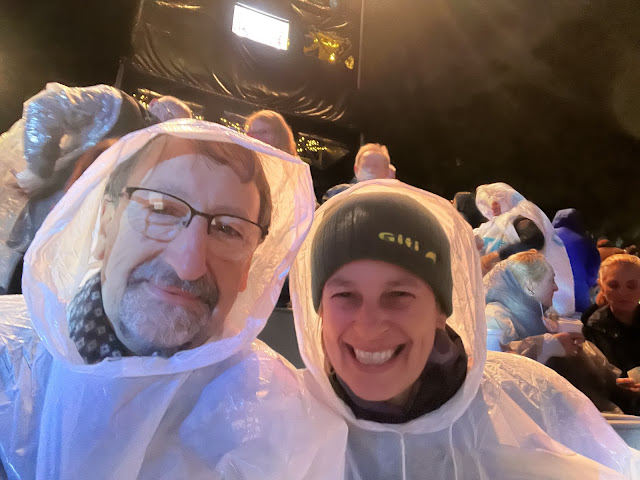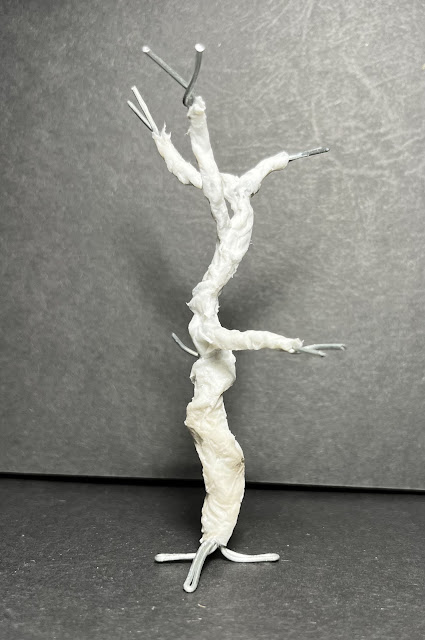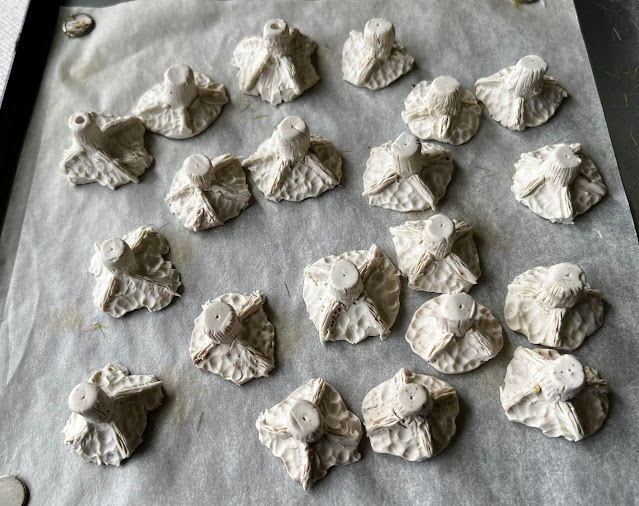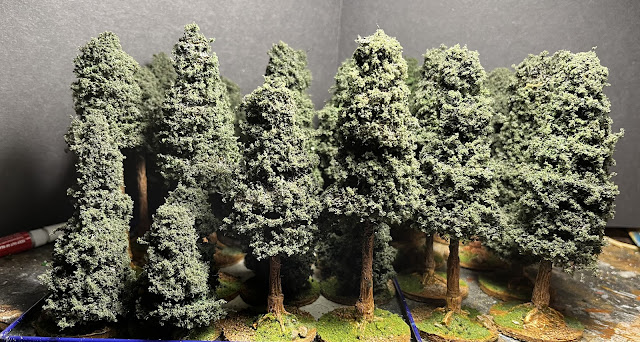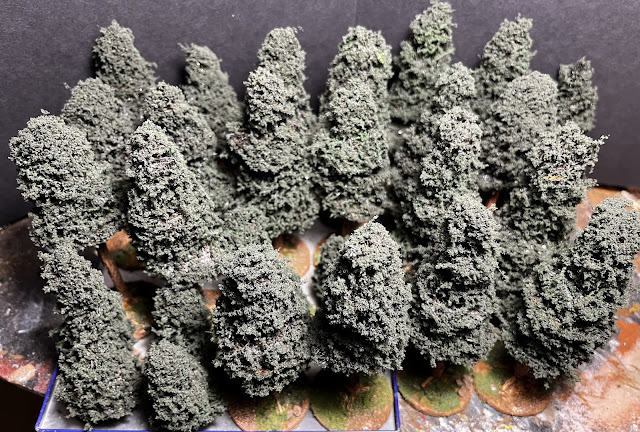Continuing my work as a miniature arbourist I have made a bunch of conifer trees. This post is a sort of a tutorial of how I made them. I take pains to point out that this is not my concept, the YouTube tutorial I based my process on can be found here - I have just added some twists of my own.
But first to honour a promise I made to Stew, here is a quick tutorial of how I make my deciduous tree armatures. Now there are plenty of YouTube tutorials about how to make superbly detailed and delicate armatures, but this is my way of making my armatures that are robust and will stand up to the rigours of the gaming table.
For this exercise I have used some 18 gauge (1.25mm diameter) tie wire, although 20 gauge wire is preferred - I just didn't have any to hand. I cut four pieces of wire between 200mm (8") 300mm (12") long and folded them in half.
Then holding the bent end of the wire in a pair of pliers about 12mm (half an inch) in from the end, I loosely twisted the two strands of wire together, leaving the open end in a fork of about 12mm.
Next I took one of the long pieces and one of the shorter pieces and holding both ends again about 12mm from the bottom and twisted the shorter piece around the larger one, leaving about 40mm (one and a half inches) bend out at an angle from the 'trunk'.
I continued to twist the other pieces around the trunk again leaving about 40mm bend out at an angle from the trunk. As these pieces are twisted together the trunk thicken and distorts the shape into gnarly trunk. I bent and twisted the branches as required.
I bent out the bottom pieces out at angles to the trunk to create the roots. At this point some lower branches were added by twisting shorter pieces of wire through the trunk. With a lighter gauge wire it is possible to add quite a few more branches if needed and I would normally put three of four more on than I have here, but it since this to a tutorial piece I will leave it at one extra.
The next step is to create the trunk over the wire. For this I use toilet paper and PVA glue. I coated the wire with PVA and begin wrapping the toilet paper around the wire. I kept wrapping the paper around, applying water thinned PVA as I went. As the paper built up and the trunk took shape.
I kept working up the tree and around the branches. Before the paper and PVA dries it is possible to etch some lines to give the appearance of bark, but I haven't done that here because I am happy enough with the wrinkled appearance. The paper and glue were left to dry.
Once dry the armature was then fixed to a base and the wire roots were covered with more toilet paper papier mâché.
Then the armature was painted. I start with a burn sienna, then drybrushed two or three lighter tones over top. With a little bit of ground texture around the base it's job done. Certainly this is not a quick process and it would be quicker to user a commercial product (although if you are reasonably organised, working just a couple of hours a night will see a pretty good number of armatures completed over a week), but making it yourself is hugely satisfying.
Now onto the conifers.
The Materials List
- Bamboo Skewers
- Coconut fibre hanging basket liner
- MDF bases
- Can of black spray paint
- A small amount of Sculpey
- Woodlands Scenic course turf, conifer, flock
- PVA glue
- Model paints - a couple of brown tones
- Ground covering
- 6mm x 3mm rare earth magnets
The first thing I did was use the Sculpey to make the stumps into which the trees would plug. I thought about making a master and then a push mould, but it was only 20 pieces and it's not like I have any figures to paint. It only took a a few hours over a couple of nights.
Each stump was then drilled and a piece of skewer glued in place. The skewers were cut to three different lengths for variety. The whole piece was ten fixed to a MDF base.
The coconut matting, which comes as a disc, was cut into four quarters. The quarters were then cut into three 'slices'.
The slices are then cut into a number of irregular discs of various sizes and the discs are split in two, or three if the matting is as thick as the piece I am using here.
The discs are then skewered through with the widest discs on the bottom and the narrowest on the top, although sizing is not too important at this point as they can be trimmed later. The idea is to create an irregular shape and the purpose of the coconut matting is really just creating the bulk and basic shape. Each layer of discs is held in place on the skewer with a drop of PVA.
I also made some smaller trees in pairs. These will sit between the larger trees and provide some density to the pine forests.
The whole tree is then sprayed black - you could use dark green, but in my view black is better - and left to dry...well away from the house otherwise there are many complaints of "...oh that smelly stuff again...." This step is important for two reasons: first, the dark colour conceals the brown of the coconut fibre, providing depth, and second, the paint helps to bond the coconut fibres together. When it is dry the trees can be given a bit of a haircut to get rid off the odd stray strand.
 |
Now to the messy part as each tree has PVA applied. The glue is another important component in making these trees wargamer-proof, binding the coconut matting even more. I prefer to apply it by brush, but I suppose it could be dipped or spray adhesive could be used, although I have had variable results with the spray. Then sprinkle the flock over the glue and leave it overnight to dry. |
The final step is to paint the trunks and texture the bases. And there we have it, 26 conifer tree stands.
Here they are fitted into the woods bases.
And the cost? Total materials cost was $32.42 which gave a unit price of $1.30 (US0.78 or £0.62). There maybe cheaper sources from China, but they aren't wargamer-proof and besides I like making stuff.











































